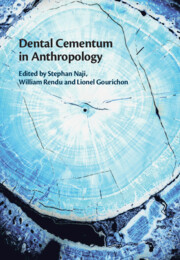Book contents
- Dental Cementum in Anthropology
- Dental Cementum in Anthropology
- Copyright page
- Dedication
- Contents
- Contributors
- Foreword
- Introduction: Cementochronology in Chronobiology
- Part I The Biology of Cementum
- 1 A Brief History of Cemental Annuli Research, with Emphasis upon Anthropological Applications
- 2 Development and Structure of Cementum
- 3 Insights into Cementogenesis from Human Disease and Genetically Engineered Mouse Models
- 4 A Comparative Genetic Analysis of Acellular Cementum
- 5 Pattern of Human Cementum Deposition with a Special Emphasis on Hypercementosis
- 6 Recent Advances on Acellular Cementum Increments Composition Using Synchrotron X-Radiation
- 7 Incremental Elemental Distribution in Chimpanzee Cellular Cementum: Insights from Synchrotron X-Ray Fluorescence and Implications for Life-History Inferences
- 8 Identifying Life-History Events in Dental Cementum: A Literature Review
- Part II Protocols
- Part III Applications
- Index
- Plate Section (PDF Only)
- References
1 - A Brief History of Cemental Annuli Research, with Emphasis upon Anthropological Applications
from Part I - The Biology of Cementum
Published online by Cambridge University Press: 20 January 2022
- Dental Cementum in Anthropology
- Dental Cementum in Anthropology
- Copyright page
- Dedication
- Contents
- Contributors
- Foreword
- Introduction: Cementochronology in Chronobiology
- Part I The Biology of Cementum
- 1 A Brief History of Cemental Annuli Research, with Emphasis upon Anthropological Applications
- 2 Development and Structure of Cementum
- 3 Insights into Cementogenesis from Human Disease and Genetically Engineered Mouse Models
- 4 A Comparative Genetic Analysis of Acellular Cementum
- 5 Pattern of Human Cementum Deposition with a Special Emphasis on Hypercementosis
- 6 Recent Advances on Acellular Cementum Increments Composition Using Synchrotron X-Radiation
- 7 Incremental Elemental Distribution in Chimpanzee Cellular Cementum: Insights from Synchrotron X-Ray Fluorescence and Implications for Life-History Inferences
- 8 Identifying Life-History Events in Dental Cementum: A Literature Review
- Part II Protocols
- Part III Applications
- Index
- Plate Section (PDF Only)
- References
Summary
Dental cementum, enveloping the tooth root and buried under the gingiva, was the last of the dental mineralized tissues to be discovered. Details of human cementum structure were not revealed until the advent of compound microscopes and invention of advanced histology techniques. The function of cementum in tooth attachment was not appreciated until nearer the end of the 19th century, when the anatomy of the periodontal complex was more fully realized. There are several unanswered questions and controversies remaining about cementum biology, however, there is no question about its critical role in tooth retention and oral health, and by extension, in overall health and quality of life. In this introductory chapter, we will summarize current knowledge of cementum biology, including cementum formation, types, composition, and clinical aspects necessary when employing and interpreting TCA measurements.
- Type
- Chapter
- Information
- Dental Cementum in Anthropology , pp. 21 - 45Publisher: Cambridge University PressPrint publication year: 2022
References
- 2
- Cited by



